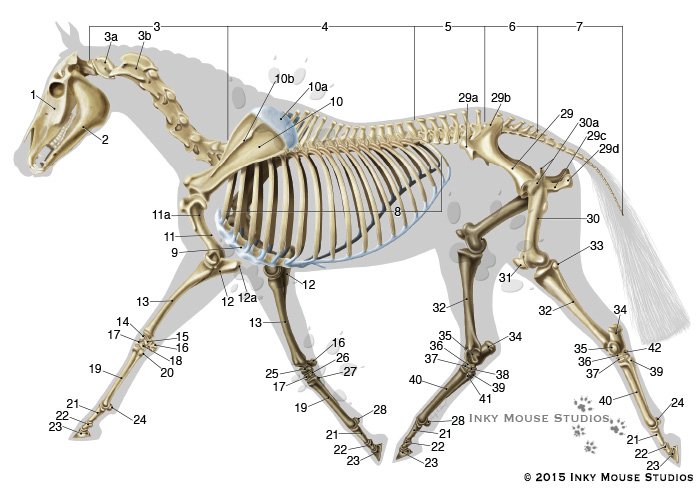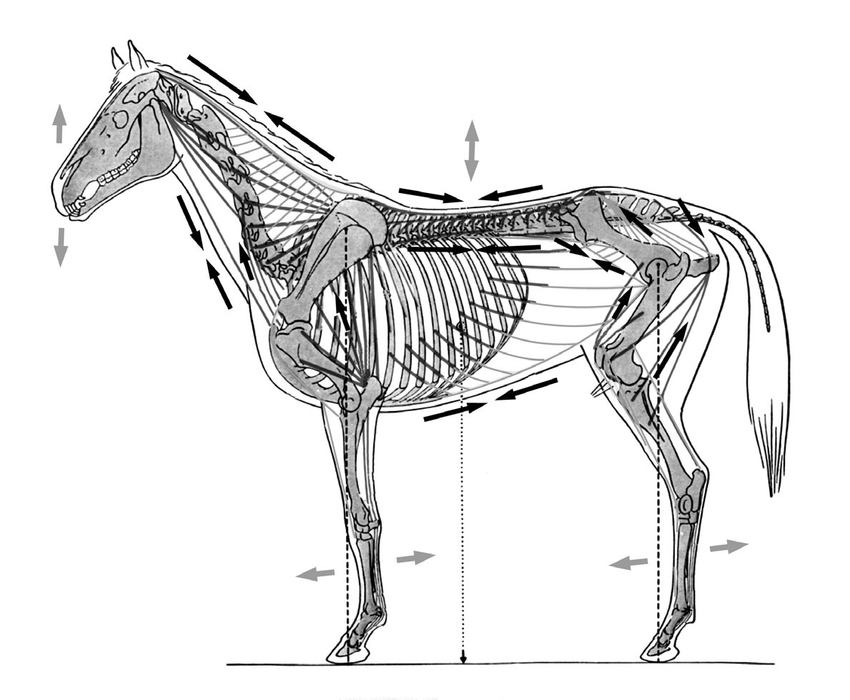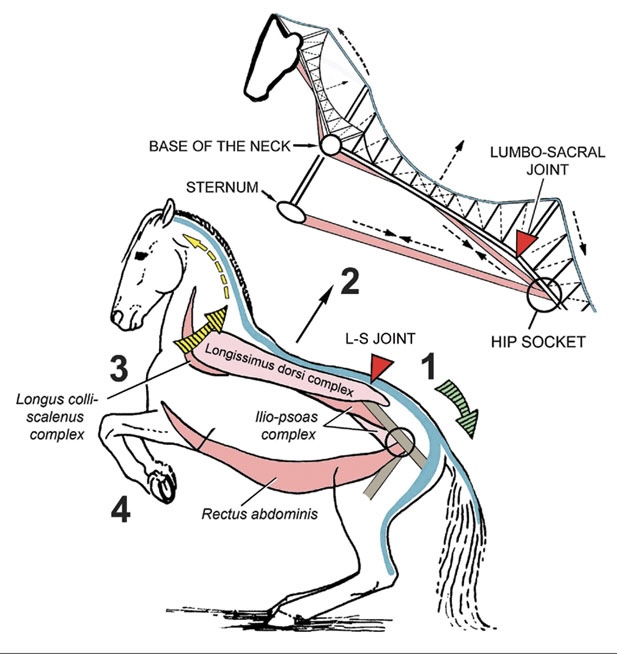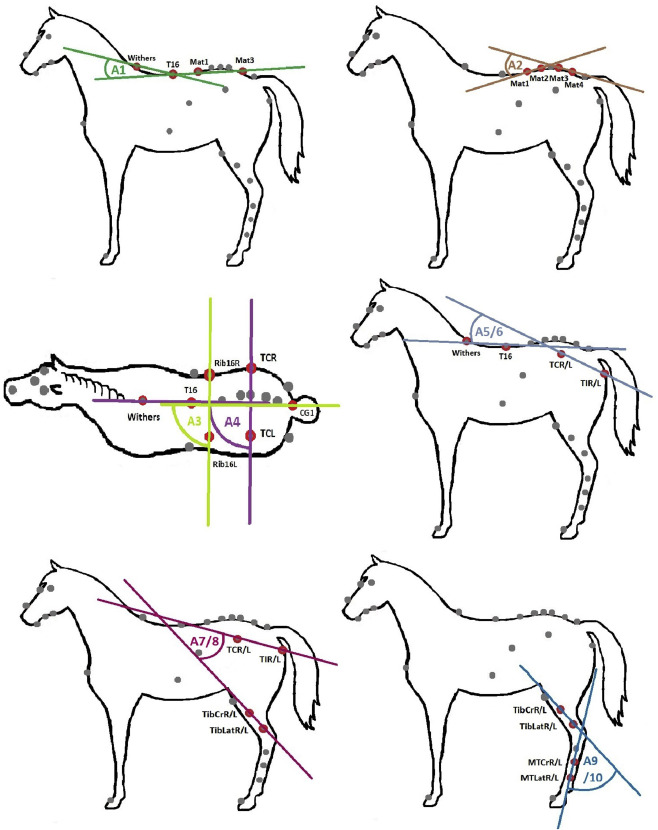
Back Spain & Foot Pathology is there a Link
Niedhart M., Stockley L., Madden N., James M. HoofFlix.Com 116, Newcastle Road, Talke. ST71SA. email info@hoofflix.com
key words: Biomechanics, Anatomy, Kinetic Energy, Potential Energy, Transition, Movement, Gait, Confirmation, Posture, Fascia,
Abstract
The propulsion of the horse is primarily generated in the pelvic limbs and transferred cranially through the spine to create forward motion. This transmission relies on efficient structural and functional integration of the musculoskeletal and fascial systems. Abnormalities in conformation or posture can disrupt these biomechanical pathways, impairing performance and predisposing the horse to injury. This review explores the anatomical and biomechanical principles underpinning power transfer from the pelvic limb through the spine, and the influence of posture and conformation on these dynamics. Additionally, the role of therapeutic farriery in mitigating dysfunctions within this kinetic chain is discussed with reference to current clinical and scientific literature.
1. Introduction
Locomotion in the horse involves complex interactions between the limbs, spine, and neuromuscular systems. The pelvic limbs are the engine of motion, generating propulsive force that is transmitted through the lumbosacral joint and spinal column to the forehand (Denoix, 2013). For this transfer to be effective, structural integrity and neuromuscular coordination must be preserved across multiple anatomical regions. Abnormalities such as pelvic asymmetry, thoracolumbar dysfunction, or hoof imbalance can disrupt this pathway, altering gait dynamics and increasing the risk of soft tissue strain and joint pathology (Clayton & Stubbs, 2016).
2. Pelvic Limb Propulsion: Anatomy and Function
The hindlimbs produce propulsion via the coordinated contraction of powerful muscle groups: the gluteals, hamstrings, and quadriceps. The force is directed through the coxofemoral joint, into the femur, stifle, tarsus, and metatarsophalangeal (fetlock) joint, with the suspensory ligament and superficial/deep digital flexor tendons absorbing and releasing elastic energy (Haussler, 1999).

figure 1. Skeletal anatomy of the equine. The illustration highlights the inter connectivity of equine skeleton (photo credit inky mouse)

Figure 2. Muscular, tendinous and bony structures interacting in the bow-and-string model: black arrows represent the pulling direction of the tendons and direction of muscle contraction, and grey arrows represent the movement of the head, back and limbs in one plane (Adapted from: Nickel et al (1986).
3. Lumbosacral Joint and Power Transmission
The lumbosacral joint (L6-S1) is a critical fulcrum where hindlimb-generated force is converted into forward momentum. During propulsion, the joint undergoes controlled flexion and extension, transmitting force into the sacroiliac joint (SIJ) and thence through the pelvis and thoracolumbar spine (Licka et al., 2001).
Spinal segmental stability and mobility are essential here. Dysfunction or restricted mobility at the SIJ or lumbosacral junction is associated with reduced stride length, altered thoracolumbar movement, and compromised performance (Stubbs et al., 2010).

Figure 4. Lumbar sacroiliac joint power transfer one the bow and string theory. (Photo credit AFJ Dr. D. Bennett.
4. Fascia and Myofascial Kinetic Chains
The thoracolumbar fascia, longissimus dorsi, and iliopsoas complex play a major role in transmitting force. Fascial continuity forms kinetic chains—namely the deep longitudinal and lateral fascial lines—that link pelvic musculature with the epaxial musculature and scapulothoracic sling (Myers, 2013; Schilling & Stubbs, 2019).
Compromise in fascial glide, due to scarring or muscular hypertonicity, can diminish mechanical efficiency and increase compensatory loading elsewhere in the system.
5. Influence of Conformation and Posture
Poor conformation—e.g., a long weak loin, canted pelvis, or straight hindlimb—can predispose the horse to abnormal load distribution across joints and soft tissues (Dyson, 2011). For example:
A tucked pelvis and excessive lumbar lordosis can reduce power transfer efficiency and overload the sacroiliac joint.
A postural anterior pelvic tilt may shift the center of mass forward, reducing engagement and affecting the interaction between hindfoot loading and fetlock hyperextension.
Postural adaptations, often secondary to pain or dysfunction (e.g., TMJ, back pain), may lead to altered hoof-ground interaction, asymmetric hoof morphology, and compensatory gait mechanics (Sharp, 2022).

Figure 5. Postural and conformational abnormalities correlate both symptomatically or causatively with both lumbar sacroiliac discomfort and dysfunctional load bearing through foot.
6. Hoof Capsule and Farriery Considerations
The hoof acts as the terminal energy converter, interfacing with the ground. Hoof balance is critical to managing ground reaction force (GRF) direction, fetlock mechanics, and deep digital flexor tendon (DDFT) tension (Eliashar et al., 2004).
Poor hind hoof conformation (e.g., negative plantar angle, underrun heels) can promote overextension of the fetlock, increasing stress on the suspensory ligament and deep flexor system (O’Grady & Poupard, 2003). Therapeutic farriery, including:
Restoration of positive plantar angle
Supportive shoes (e.g., wedge, egg-bar, or plantar extension shoes)
Rockered toes or beveling to reduce lever arm during breakover
can reduce loading on injured structures and promote more efficient power transmission through the limb and back (Adams & Stashak, 2020; Parks & Belknap, 2003).
7. Clinical and Performance Implications
Poor transmission of hindlimb power often manifests as:
Decreased engagement and impulsion
Shortened stride length behind
Sacroiliac dysfunction or pain
Stumbling or poor transitions
Saddle fit issues due to uneven muscle development
Integration of farriery, rehabilitation, dentistry, and postural therapy is often required to restore optimal biomechanical function (King et al., 2013).
8. Conclusion
Understanding the biomechanical principles governing hindlimb-to-spine power transition is essential for diagnosing and treating performance issues in the horse. The horse’s conformation and hoof mechanics are inseparably linked to posture and spinal function. Farriery plays a pivotal role in restoring biomechanical efficiency by optimizing limb-ground interaction and mitigating maladaptive loading patterns. A collaborative, whole-horse approach is required to address dysfunctions and enhance athletic performance.
References (Harvard Style)
Adams, O.R. & Stashak, T.S., 2020. Adams’ Lameness in Horses. 7th ed. Wiley-Blackwell.
Clayton, H.M. & Stubbs, N.C., 2016. The relationship between hind limb step length and lumbar spine movement in the equine trot. Equine Veterinary Journal, 48(4), pp.451–456.
Denoix, J.M., 2013. Biomechanics and Physical Training of the Horse. CRC Press.
Dyson, S., 2011. Back pain in the horse: a clinical approach. Equine Veterinary Education, 23(10), pp.489–498.
Eliashar, E., McGuigan, M.P. & Wilson, A.M., 2004. Relationship of foot conformation and force applied to the navicular bone of sound horses at the trot. Equine Veterinary Journal, 36(5), pp.431–435.
Haussler, K.K., 1999. Functional anatomy and pathophysiology of the equine back. Veterinary Clinics of North America: Equine Practice, 15(1), pp.13–26.
King, M.R., Haussler, K.K. & Kawcak, C.E., 2013. Pathophysiology of the sacroiliac joint. Veterinary Clinics: Equine Practice, 29(1), pp.59–70.
Licka, T.F., Peham, C. & Scheidl, M., 2001. Centrifugal force effect on intervertebral motion during lungeing. Equine Veterinary Journal Supplement, (33), pp.66–70.
Myers, T.W., 2013. Anatomy Trains: Myofascial Meridians for Manual and Movement Therapists. 3rd ed. Elsevier.
O’Grady, S.E. & Poupard, D.A., 2003. Physiological horseshoeing: an overview. Equine Veterinary Education, 15(3), pp.160–167.
Parks, A.H. & Belknap, J.K., 2003. Farriery for the treatment of lameness. In: M. Ross & S. Dyson, eds. Diagnosis and Management of Lameness in the Horse. Philadelphia: Elsevier, pp.247–269.
Schilling, N. & Stubbs, N.C., 2019. Fascial anatomy and biomechanics of the equine thoracolumbar region. Equine Veterinary Journal, 51(4), pp.472–479.
Sharp, Y., 2022. Effects of Changing Dorso-Plantar Hoof Balance on Equine Hind Limb Posture. Animals, 12(23), 3275.
Stubbs, N.C. et al., 2010. Movement asymmetries in the equine back. Equine Veterinary Journal, 42(S38), pp.559–565.
See our great video tutorials in the mythbusters series
https://hoofflix.com/media/videos/biomechanics/hoof-care-the-whole-horse-connection/
